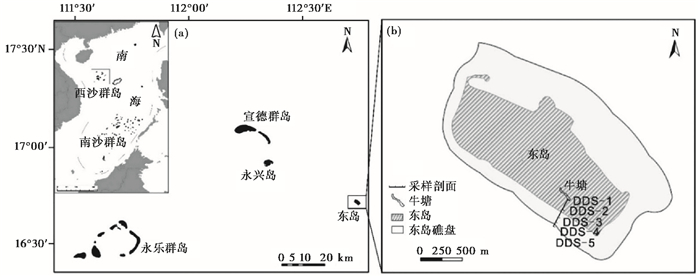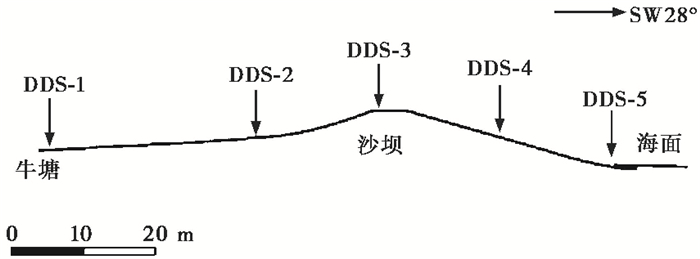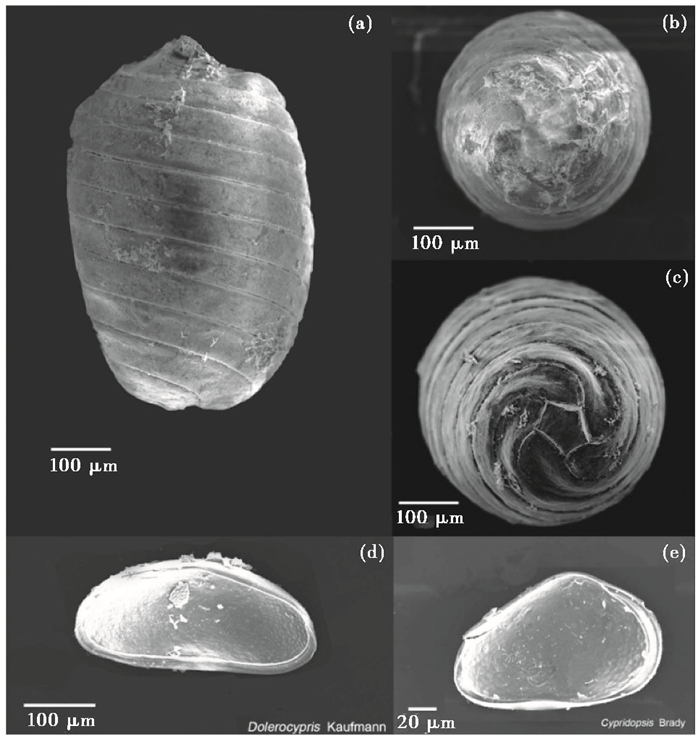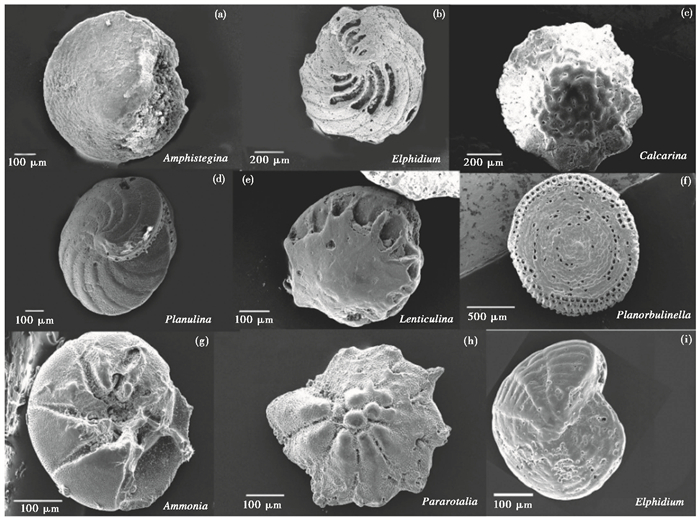2 南京大学中国南海研究协同创新中心, 江苏 南京 210023;
3 南京大学地理与海洋科学学院, 江苏 南京 210023)
西沙群岛位于南海中部,是发育于热带海洋的珊瑚岛屿,以环带状分布的乔木、灌木等单优势植被群落为特征的热带珊瑚小岛生态系统,构成了历史时期西沙群岛原生生态景观的主要特征[1]。我国自20世纪70年代末以来,对西沙群岛植被进行过多次系统调查。1974年,广东省植物研究所西沙群岛植物调查队,对西沙群岛的植物和植被进行了系统地考察[2];1991年,海南省海岛资源综合调查领导大队对西沙群岛的水文、海洋生物、海岛资源环境做了更加细致全面的调查[3];中国科学技术大学西沙科考队也在2003年对西沙群岛生态环境做了考察,并出版了大量论文和专著[4];张浪等[5]于2008年对西沙群岛植被进行调查,邓双文等[6]2016年对西沙群岛植物进行了调查和补充;刘晓瞳等[7]对牛塘沉积物钻孔进行了微体古生物组合分析。东岛是位于西沙群岛东部的珊瑚岛,岛上发育了淡水湖泊“牛塘”,为珊瑚岛屿淡水生态系统的研究提供了良好的范本。在西沙群岛东岛上,植被主要有Pissonia grandis(白避霜花)、Guttarda speciosa(海岸桐)等常绿乔木,Scaevola sericea(草海桐)、Pemphis acidula(水芫花)等热带灌木,Thuarea involuta(萏蕾草)、Sporobolus virginicus(盐地鼠尾草)等沙生植被,以及Sesuvium portulacastrum(海马齿)等珊瑚岛沼湖植被;调查中至今并未出现对西沙群岛东岛轮藻植物的报道[2~7]。本文在对东岛湖泊沉积物的微体古生物分析中,发现了轮藻植物藏卵器,表明东岛淡水湖泊中出现了轮藻植物,其生态系统发育进入了新的阶段。
1 环境概况东岛位于西沙群岛东部(图 1),面积约1.7072 km2,是西沙群岛第二大岛。东岛属于热带季风气候,年平均气温26~27 ℃,年降雨量约1500 mm,6~11月为雨季,其降雨量占全年的87 %,12月至次年5月为干季[1]。“牛塘”是东岛东南部沙堤内天然形成的湖泊,其形状为新月形,长度在约100 m,最宽处约20 m,水深通常在0.5 m以下,是岛上唯一的天然淡水湖泊[8]。

|
图 1 西沙群岛东岛地理位置(a)及沉积物采样剖面位置(b) 改绘自文献[7] Fig. 1 Geographical location of the Dongdao Island of Xisha Islands (a) and sampling profile (b), modified from reference[7] |
2018年3月,在西沙群岛东岛从“牛塘”至海滩采集了5个表层沉积物样品(图 1b和图 2),样品编号为DDS-1至DDS-5。样品在孔径为0.075 mm、0.25 mm、0.5 mm以及1 mm的筛网层筛并冲洗,冲洗后冻干备用。在粒径为0.5~1.0 mm与0.25~0.50 mm的沉积物样品中挑出轮藻藏卵器、有孔虫、介形虫壳体。扫描电子显微镜观察在南京大学内生金属矿床成矿机制国家重点实验室完成。中国科学院南京地质古生物研究所卢辉楠研究员进行了轮藻的鉴定,李宝华研究员进行了有孔虫的鉴定,曹美珍研究员进行了介形虫的鉴定。

|
图 2 西沙群岛东岛沉积物采样剖面示意图 Fig. 2 Sampling profile from Cattle Pound to the sand beach in Dongdao Island |
西沙群岛东岛表层沉积物样品微体古生物组合特征见表 1。采集自“牛塘”的表层沉积物DDS-1为颗粒均匀的棕黄色沉积物,可见少量植物残体,其中有大量轮藻藏卵器以及介形虫壳体。经鉴定,为Lamprothamnium(丽枝轮藻)的藏卵器和Heterocypris (喜盐异星介)、Dolerocypris(薄壳介)以及Cypridopsis(斗星介)壳体(图 3)。
| 表 1 西沙群岛东岛表层沉积物微体古生物组合特征 Table 1 Characteristics of microfossil assemblages in surface sediments of Dongdao Island |

|
图 3 DDS-1表层沉积物中轮藻及介形虫组合 (a~c) Lamprothamnium藏卵器,其中(a)侧视,×80,(b)顶视,×80,(c)底视,×82;(d) Dolerocypris(薄壳介),×90;(e)Cypridopsis(斗星介),×220 Fig. 3 The Charophytes and Ostracods assemblage in the sample D DS-1 from Dongdao Island, Xisha Islands.(a~c)Lamprothamnium, and (a)side view, ×80, (b)top view, ×80, (c) bottom view, ×82; (d)Dolerocypris, ×90; (e)Cypridopsis, ×220 |
Lamprothamnium藏卵器有较大的冠,由5个包围细胞自然融合,形状大多为长球形,少部分为亚长球形,顶部结构为典型的轮藻型,钙化程度大多为中等钙化或较差钙化。藏卵器最大长度(LPA)为560~780 μm,最大宽度(LED)为360~500 μm,等轴率(ISI)为156~194(图 3);Lamprothamnium具有良好耐盐性,多分布于沿海岸地区的微咸水、半咸水以及咸水湖泊中[9]。而Heterocypris喜栖息于盐度不超过2.0 %的淡咸水中,如海洋或者咸水湖泊的沿岸带,偶尔也出现于淡水水体中;Dolerocypris常生活于湖泊浅水带以及各种小型水体中,世界各地均有分布;Cypridopsis常生活于水生植物茂密的水体,不喜缺氧的环境[10]。牛塘中的轮藻以及介形虫组合说明其生长于淡水或淡咸水环境。
样品DDS-2至DDS-5均为粗颗粒珊瑚砂,颗粒不均匀,DDS-2与DDS-3珊瑚砂为灰色至白色,其中可见少量植物残体,DDS-4与DDS-5中珊瑚砂为白色。微体古生物均以有孔虫为主,DDS-2与DDS-3中有孔虫化石磨蚀程度较高,DDS-4与DDS-5中有孔虫化石磨蚀程度低。经鉴定,有孔虫包括双盖虫(Amphistegina,图 4a)、希望虫(Elphidium,图 4b和4i)、马刺虫(Calcarina,图 4c)、平面虫(Planulina,图 4d)、透镜虫(Lenticulina, 图 4e)、小平圆虫(Planorbulinella,图 4f)、卷转虫(Ammonia,图 4g)以及仿轮虫(Pararotalia,图 4h)等,未发现有轮藻以及介形类出现。

|
图 4 西沙群岛东岛沉积物样品DDS-2至DDS-5中有孔虫组合 Fig. 4 The Foraminifera assemblages in the sample DDS-2 to DDS-5 from Dongdao Island, Xisha Islands (a) Amphistegina, ×45; (b)Elphidium, ×35;(c)Calcarina, ×40;(d)Planulina, ×45;(e)Lenticulina, ×70;(f)Planorbulinella, ×22;(g)Ammonia, ×110;(h)Pararotalia, ×90;(i) Elphidium, ×90 |
2015年8月,刘晓瞳等[7]在牛塘中采集了钻孔DD-01,该钻孔全长60 cm,在钻孔深度为0~28 cm以及34~40 cm的样品中出现了淡水湖相介形虫,钻孔中没有出现轮藻的藏卵器。2003年3月,孙立广和刘晓东[4]分析了采集自牛塘的DY2、DY4与DY6沉积物钻孔,表层沉积物以及距今1300年左右的沉积单元均为封闭湖泊沉积,3根钻孔中均没有轮藻藏卵器出现。因此可以推测,轮藻植物是在近几年才在牛塘中出现的。
此次在西沙群岛东岛的淡水湖泊中发现的丽枝轮藻为轮藻在南海海域的首次发现。东岛是远离大陆的珊瑚岛,岛上发育的生态系统比较孤立和脆弱,牛塘作为岛上唯一的淡水湖泊,其生态环境更为独特,受到人类活动影响相对较小[11]。轮藻植物往往是原生生态系统中的先锋物种[12],牛塘中淡水轮藻植物的出现意味着,此处的淡水生态系统发育到了更加稳定的阶段[13]。轮藻植物在低营养环境下相较于被子植物更具有生长优势,能够迅速繁殖,改善生态环境。轮藻植物作为湖泊生态系统的初级生产者直接为消费者提供物质来源,参与到生态系统能量流动和物质循环中[14]。轮藻植物能够显著提高水体透明度,通过碳酸钙沉降有效降低湖水中Ca2+浓度,改善湖泊水质[15],为大型水生植物的出现奠定基础。轮藻植物在湖泊底部生长繁殖,能够稳定湖泊底质防止湖底沉积物质再悬浮,并且为小型底栖生物以及浮游动物提供栖息地并供给食物[15~16]。
本属中被公认的有6种,分布于澳大利亚沿岸以及地中海沿岸[17],也有报道认为该属我国广东沿岸有分布[18]。牛塘位于西沙群岛东岛,其周围都是海洋环境,在此次采集的表层沉积物剖面中,除了采集自牛塘中的DDS-1表层沉积物之外,其他样品中均没有发现淡水介形类以及轮藻藏卵器。西沙群岛是西北太平洋重要的海鸟聚集区和鸟类迁徙中间站,东岛是鸻鹬类和燕鸥类海鸟在东亚-澳大利亚迁徙路上的栖息场所[19]。东岛上的丽枝水轮藻可能是由迁徙的海鸟携带至此,在牛塘中萌发,进一步生长繁殖。
轮藻植物除具备重要的生态意义外,还具有广泛的经济价值[20]。南沙群岛的人工岛礁上淡水奇缺,岛上军民用水主要依靠大陆补给、雨水储存和海水淡化,轮藻植物具备净化水质的特点,能够有效改善水质,稳定湖泊生态系统,对南海岛礁的建设以及生态环境的保护有重要意义。
致谢: 东岛表层样品采集在何胜先生大力帮助下完成;轮藻、介形类和有孔虫的鉴定由中国科学院南京地质古生物研究所卢辉楠、曹美珍和李保华研究员完成;中国科学院地质与地球物理研究所谭明研究员对论文的写作提供了建设性意见。在此一并致谢。
| [1] |
广东省植物研究所西沙群岛植物调查队. 我国西沙群岛的植物和植被[M]. 北京: 科学出版社, 1977: 46-55. Plant Investigation Team of Xisha Islands, Guangdong Institute of Botany. Plants and Vegetation of Xisha Islands, China[M]. Beijing: Science Press, 1977: 46-55. |
| [2] |
钟义, 刘强, 钟琼芯, 等. 海南省海岛植被与林业调查研究报告[M]. 北京: 海洋出版社, 1999: 568-573. Zhong Yi, Liu Qiang, Zhong Qiongxin, et al. The Research Report of Island Vegetation and Forestry in Hainan Provence[M]. Beijing: China Ocean Press, 1999: 568-573. |
| [3] |
海南省海洋厅调查领导小组办公室. 海南省海岛资源综合调查研究专业报告集[M]. 北京: 海洋出版社, 1977: 568-573. Office of Investigation Leading Group of Hainan Oceanographic Department. Collection of Professional Reports on Comprehensive Investigation and Research of Hainan Island Resources[M]. Beijing: China Ocean Press, 1977: 46-55. |
| [4] |
孙立广, 刘晓东. 南海岛屿生态地质学[M]. 上海: 上海科学技术出版社, 2014: 39-43. Sun Liguang, Liu Xiaodong. Ecogeology of Islands in the South China Sea[M]. Shanghai: Shanghai Science and Technology Press, 2014: 39-43. |
| [5] |
张浪, 刘振文, 姜殿强. 西沙群岛植被生态调查[J]. 中国农学通报, 2011, 27(14): 181-186. Zhang Lang, Liu Zhenwen, Jiang Dianqiang. Ecological investigation in Hainan Province[J]. Chines Agricultural Science Bulletin, 2011, 27(14): 181-186. |
| [6] |
邓双文, 王发国, 刘俊芳, 等. 西沙群岛植物的订正与增补[J]. 生物多样性, 2017, 25(11): 1246-1250. Deng Shuangwen, Wang Faguo, Liu Junfang, et al. Revision and supplement to plants from Xisha Islands, China[J]. Biodiversity Science, 2017, 25(11): 1246-1250. DOI:10.17520/biods.2017066 |
| [7] |
刘晓瞳, 葛晨东, 邹欣庆, 等. 西沙群岛东岛潟湖沉积物碳、氮元素地球化学特征及其指示的环境变化[J]. 海洋学报, 2017, 39(6): 43-54. Liu Xiaotong, Ge Chendong, Zou Xinqing, et al. Carbon, nitrogen geochemical characteristics and their implications on environmental change in the lagoon sediments of the Dongdao Island of Xisha Islands in South China Sea[J]. Acta Oceanologica Sinica, 2017, 39(6): 43-54. DOI:10.3969/j.issn.0253-4193.2017.06.005 |
| [8] |
曹垒, 张苏芳, 史洪泉, 等. 西沙群岛东岛小军舰鸟繁殖种群的初步观察[J]. 动物学研究, 2003, 24(6): 457-461. Cao Lei, Zhang Sufang, Shi Hongquan, et al. Primarily observation of breeding population of great frigatebirds(Fregata minor) on Dong Island of Xisha Archipelago[J]. Zoological Research, 2003, 24(6): 457-461. DOI:10.3321/j.issn:0254-5853.2003.06.010 |
| [9] |
韩福山, 李尧英. 中国淡水藻志·第三卷, 轮藻门[M]. 北京: 科学出版社, 1994: 1-267. Han Fushan, Li Yaoying. Charophyta(Flora Algarum Sinicarum, Volume 3)[M]. Beijing: Science Press, 1994: 1-267. |
| [10] |
Ellis F Brooks, Messina R Angelina. Catalogue of Ostracoda(Volume 11)[M]. New York: The American Museum of Natural History, 1952: 145-165.
|
| [11] |
高腾云, 吕超, 傅彤, 等. 西沙群岛之东岛"野牛"及其启示[J]. 家畜生态学报, 2012, 33(2): 103-105. Gao Tengyun, Lü Chao, Fu Tong, et al. Wild cattle in Dong Island of Xisha Archipelago and its revelation[J]. Acta Ecologiae Animalis Domastici, 2012, 33(2): 103-105. DOI:10.3969/j.issn.1673-1182.2012.02.022 |
| [12] |
Nõges P, Tuvikene L, Feldmann T, et al. The role of Charophytes in increasing water transparency:A case study of two shallow lakes in Estonia[J]. Hydrobiologia, 2003, 506-509: 567-573. DOI:10.1023/B:HYDR.0000008625.36438.75 |
| [13] |
Mariusz Pełechaty, Joanna Ossowska, Andrzej Pukacz, et al. Site-dependent species composition, structure and environmental conditions of Chara tomentosa L.meadows, Western Poland[J]. Aquatic Botany, 2015, 120: 92-100. DOI:10.1016/j.aquabot.2014.06.015 |
| [14] |
兰利琼, 傅华龙, 卿人韦. 中国现生轮藻研究现状[J]. 微体古生物学报, 2003, 20(2): 147-149. Lan Liqiong, Fu Hualong, Qing Renwei. The research status of Chinese living Charophytes[J]. Acta Micropalaeontologica Sinica, 2003, 20(2): 147-149. DOI:10.3969/j.issn.1000-0674.2003.02.006 |
| [15] |
Schneider S C, García A, Martín-Closas C, et al. The role of Charophytes(Charales)in past and present environments:An overview[J]. Aquatic Botany, 2015, 120: 2-6. DOI:10.1016/j.aquabot.2014.10.001 |
| [16] |
Coops H. Ecology of charophytes:An introduction[J]. Aquatic Botany, 2002, 72: 205-208. DOI:10.1016/S0304-3770(01)00200-5 |
| [17] |
Michelle T C. Lamprothamnium in Australia(Characeae, Charophyceae)[J]. Australian Systematic Botany, 2015, 26: 218-233. |
| [18] |
Ling Y J, Xie S L, Langangen A. Charales of China[J]. Nova Hedwigia, 2000, 71(1): 69-94. |
| [19] |
中国科学院南京土壤研究所西沙群岛考察组. 我国西沙群岛的土壤和鸟粪磷矿[M]. 北京: 科学出版社, 1977: 73-89. Xisha Islands Investigation Team, Nanjing Institute of Soil Sciences, Chinese Academy of Sciences. Soil and Bird Droppings Phosphate Rock in Xisha Islands, China[M]. Beijing: Science Press, 1977: 73-89. |
| [20] |
韩晓静, 何雨原, 崔晓波, 等. 轮藻植物的经济价值及应用前景[J]. 中国科技信息, 2008(10): 70-71. Han Xiaojing, He Yuyuan, Cui Xiaobo, et al. Economic value and application prospect of charophytes[J]. China Science and Technology Information, 2008(10): 70-71. |
2 Collaborative Innovation Center of South China Sea Studies, Nanjing University, Nanjing 210023, Jiangsu;
3 School of Geographic and Oceanographic Sciences, Nanjing University, Nanjing 210023, Jiangsu)
Abstract
Coral reefs are widely distributed in the South China Sea. The development and construction of coral reefs in the South China Sea, especially the construction of artificial reefs in the South China Sea, have attracted wide attention in recent years. In March 2018, we collected 5 surface samples in Dongdao Island, Xisha Islands. After microscopic observation, charophyte oogoniums were found in the surface sediments of freshwater lakes on the Dongdao Island, Xisha Islands. Charophytes were found in Xisha Islands for the first time. This discovery means that the freshwater ecosystem here has entered a more stable new stage. Upon appraisal, these oogoniums belong to Lamprothamnium, most of the oogoniums are prolate, the others are subprolate. The largest polar axis (LPA) is 560~780 μm, the largest equatorial diameter (LED) is 360~500 μm, the isopolarity index (ISI) is 156~194. These features accord with Lamprothamnium oogonium. Living charophytes were found in Xisha Islands for the first time, which means the freshwater ecosystem in Dongdao Island developed to a more stable stage. This discovery is important for the study of freshwater ecosystem in Xisha Islands, which also provide scientific basis for the management and protection of the freshwater ecosystem of the coral reefs in the South China Sea, especially for the construction of artificial reefs in the South China Sea. 2019, Vol.39
2019, Vol.39

